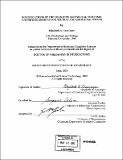| dc.contributor.advisor | Suzanne Corkin. | en_US |
| dc.contributor.author | Kensinger, Elizabeth A. (Elizabeth Ann), 1976- | en_US |
| dc.contributor.other | Massachusetts Institute of Technology. Dept. of Brain and Cognitive Sciences. | en_US |
| dc.date.accessioned | 2005-10-14T20:05:21Z | |
| dc.date.available | 2005-10-14T20:05:21Z | |
| dc.date.copyright | 2003 | en_US |
| dc.date.issued | 2003 | en_US |
| dc.identifier.uri | http://hdl.handle.net/1721.1/29362 | |
| dc.description | Thesis (Ph. D.)--Massachusetts Institute of Technology, Dept. of Brain and Cognitive Sciences, 2003. | en_US |
| dc.description | Includes bibliographical references. | en_US |
| dc.description.abstract | The cognitive and neural processes underlying memory formation may differ depending on the vividness, or detail, of information encoded. In Chapter 1, a divided attention paradigm was used to examine memory formation when resources are (a) devoted primarily to encoding and (b) directed away from encoding, and toward a secondary task. In condition (b) the memories formed often lacked vividness. The formation of these less detailed memories recruited right inferior prefrontal cortex (PFC) and left parahippocampal gyrus. The left inferior PFC and left anterior hippocampus were additionally recruited in condition (a) when vivid memories could be formed. Investigations of memories' vividness have typically included only neutral information. The studies in Chapter 2 revealed that emotional information is vividly remembered more frequently than information lacking emotional import. This enhancement occurred for words with valence only (i.e., negative words that did not elicit physiological arousal) as well as for arousing ("taboo") words, but was stronger for the arousing words. In Chapter 3 a divided attention paradigm was employed to investigate the contributions of automatic and controlled processing to the recollective enhancement for the emotional words. Automatic processes (unaffected by task manipulation) drove the enhancement for arousing words, whereas controlled processes (disrupted by task manipulation) supported the enhancement for words with valence only. Thus, dissociable cognitive processes contributed to the enhancement for the two types of emotional words. In Chapter 4, fMRI was used to examine whether distinct encoding processes underlie enhanced memory for words with valence only versus words with arousal. | en_US |
| dc.description.abstract | (cont.) Successful encoding of words with valence only was via a PFC-hippocampal network associated with controlled encoding processes (e.g., elaboration and rehearsal), whereas successful encoding of arousing words was mediated by an amygdalar-hippocampal network that may be important for automatic processing of emotional content. In conclusion, distinct neural processes appear to support the ability to form vivid memories as compared to less detailed ones. The specific cognitive and neural processes depended on the emotional nature of the stimuli. Vividly-remembered neutral words, and words with valence only, relied on similar encoding processes. In contrast, dissociable processes mediated successful encoding of vividly-remembered arousing words. | en_US |
| dc.description.statementofresponsibility | by Elizabeth A. Kensinger. | en_US |
| dc.format.extent | 141 leaves | en_US |
| dc.format.extent | 6270119 bytes | |
| dc.format.extent | 6269927 bytes | |
| dc.format.mimetype | application/pdf | |
| dc.format.mimetype | application/pdf | |
| dc.language.iso | eng | en_US |
| dc.publisher | Massachusetts Institute of Technology | en_US |
| dc.rights | M.I.T. theses are protected by copyright. They may be viewed from this source for any purpose, but reproduction or distribution in any format is prohibited without written permission. See provided URL for inquiries about permission. | en_US |
| dc.rights.uri | http://dspace.mit.edu/handle/1721.1/7582 | |
| dc.subject | Brain and Cognitive Sciences. | en_US |
| dc.title | Investigations of the cognitive and neural processes supporting memory for neutral and emotional words | en_US |
| dc.type | Thesis | en_US |
| dc.description.degree | Ph.D. | en_US |
| dc.contributor.department | Massachusetts Institute of Technology. Department of Brain and Cognitive Sciences | |
| dc.identifier.oclc | 52787444 | en_US |
